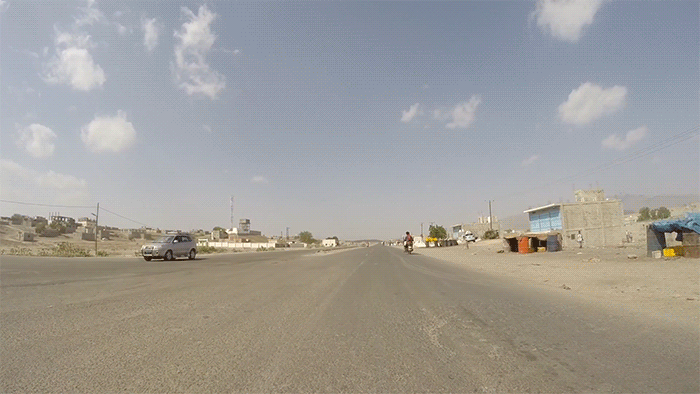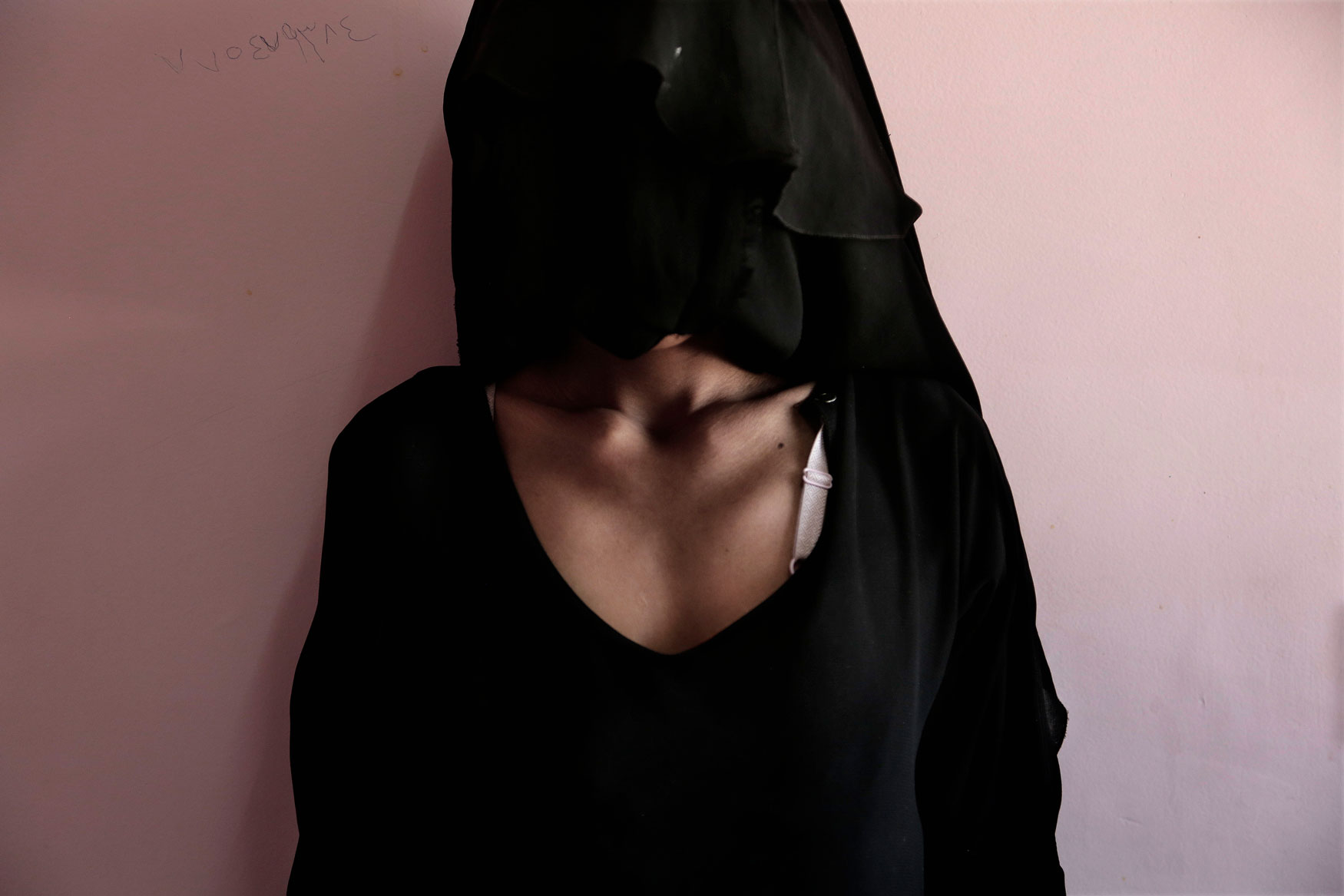Desperation, hunger mark trip through war-torn Yemen

Across Yemen, there is a landscape of desperation.
People driven from their homes by war live in tents made of rags and sticks. Hungry mothers beg in markets full of food that few can afford. Families that were once comfortably middle class have been reduced to grinding poverty, unsure where their next meal will come from. Scrawny, underdeveloped children run through unpaved streets.
Yemen’s 3-year-old civil war has pushed the country into near starvation as a U.S.-backed, Saudi-led coalition supporting the government tries to drive back Shiite rebels known as Houthis. Thousands of children are already believed to have died, though there are no solid statistics. Aid agencies warn the worst is potentially still to come.
The Associated Press drove more than 700 kilometers (400 miles) across southern and western Yemen to look at the lives of people in areas that are most at risk of famine. The team’s path took them from the urban center of Aden to isolated mountain valleys, through plains where the mountains sweep down to the Arabian Sea, to towns on the Red Sea coast cut off by the shifting front lines in the civil war.
All along the way was a population in chaos.
ADEN
Al-Sadaqa Hospital in Aden, Yemen (AP Photo/Nariman El-Mofty)
The hallmarks of starvation are clear on 7-month-old Ahmed Rasheed Moqbal. His face is like an old man, the skin on his buttocks sags. He cries constantly, with almost no tears. He weighs only 3.3 kilograms (7 pounds).
His mother, Aisha Mohammed, is also severely thin. At Aden’s Al-Sadaqa Hospital, she steps on the scale: 39 kilograms (86 pounds)
She and her family were driven by fighting from their home, 160 kilometers (100 miles) to the west in the district of Mowza. Here in Aden, her husband works hauling bricks at a construction site. But he hardly makes enough to feed them. Mohammed’s two other children are also malnourished.
Aden’s Al-Sadaqa is the main hospital serving the worst malnutrition cases from around southern Yemen. It’s the best supplied, from aid coming into Aden’s port. Struggling hospitals around the south send their worst malnutrition cases here, since they can’t handle them.
But the large majority of families with starving children can’t afford the trip to Aden. So they sit at home and their children get worse.
AL-MALLAH, LAHJ PROVINCE
Lahj, Yemen. (AP Photo/Nariman El-Mofty)
Isolated in a mountain valley, the 450 residents of the village of Qibli are wasting away. Most of the men here are soldiers, who haven’t been paid for months, or farm laborers, who can no longer find work.
Any money they have goes in search of food, and it’s never enough. Aid hasn’t come Qibli since 2016. That’s in part because most households here are considered to have a male breadwinner, making them lower in priority for humanitarian agencies.
Sherine’s husband is among the ranks of unpaid soldiers. His father, a retired soldier, still gets a meager pension but he spreads that around to help his 16 children and grandchildren. Sherine’s 1-year-old daughter Amal, has been diagnosed with acute malnutrition and can’t support herself on her legs.
She feeds them scraps of bread dipped in “besbas,” a sauce of tomato and garlic. She didn’t take any bites herself. Asked if she eats well, she said in a barely audible voice, “God willing.”
At the area’s largest city, al-Mallah, Umm Molham sits on a bed in the main hospital waiting for doctors who haven’t shown up for three days. No one pays the hospital staff, so they don’t regularly report to work.
She’s so weak she can barely lift her 13-month-old son, Molham, who has been suffering from rounds of vomiting and diarrhea. She’s unable to breastfeed, and even when asked questions, she hardly says a word, as if lost in her internal world of frailty and hunger.
RED STAR
Abyan, Yemen. (AP Photo/Nariman El-Mofty)
Some 18,000 people in recent months have fled war zones further west and streamed into Abyan province. Many of them now struggle to have enough food.
And they have slammed Abyan’s own population of 560,000, themselves barely able to feed their families.
Some 30,000 children under 5 in the province suffer from malnutrition, according to UNICEF. Over the past year the number of people in acute need of aid in Abyan grew from 273,000 to 336,000.
Hagar Yahia, her husband and eight children, escaped fighting on the Red Sea coast and now live in a hut of rags in the village of Red Star in Abyan. She sometimes works at nearby farms, and her husband, Mohammed Nasser, looks for woodcutting jobs. On a good day, they can afford some vegetables or bits of fish for their one meal a day. But most often, they eat the thick, heavy bread called “tawa” that fills the stomach, washed down with sweetened tea.
“I go hungry for my children. I prefer that I don’t eat so they can,” she said. “When they ask for something and I can't afford, it burns me from inside."
Her youngest, 5-year-old Awsaf, has been deteriorating ever since they arrived and is malnourished.
"My husband cries at night for the children and for us," Yahia said. "I tell him to leave it to God."
AL-KHOUKHA
Al-Khoukha, Yemen. (AP Photo/Nariman El-Mofty)
Mothers carrying babies mob the nutrition center at the main hospital in al-Khoukha, hoping for baby formula and nutrient supplies. But they leave empty-handed. The center has ran out weeks ago.
Al-Khoukha was recaptured from Houthis rebels in December. But liberation cut it off from access to aid supplies from the Houthi-held port of Hodeida further north. No aid has come from the government-held south to replace it.
The shift of front lines has also caused food prices to skyrocket, since transport costs leaped more than seven times. Trucks that once made the short drive from Hodeida must now make a more than 8-hour drive from the south. Markets have food, but increasing numbers of people can’t afford it.
“We have no vaccinations. There are shortages in medicines. The aid stopped,” said Abdullah Doubala, head of al-Khoukha health department.
The burden is increasing as families fleeing fighting elsewhere stream into Khoukha, bringing more thin and hungry children.
Nine-month old Galila, her ribs sharply outlined, her eyes bugging in shrunken sockets, sat in the lap of her mother, Aisha, who fled here from further north.
The baby girl caught malaria and began to fall in weight. Now she weighs 4.5 kilograms (9.9 pounds), compared to the average of 6 to 8 kilograms (13-17 pounds) for a 9-month-old girl.
MOCHA
The road from Aden to Mocha, Yemen. (AP Photo/Nariman El-Mofty)
Even among the poor and starving, there is generosity.
In Mocha, Zahra al-Zubaidi helped families who fled here from warzones find homes in the collection of shacks where she lives in the Hasseb district. She places them in shacks abandoned by her neighbors who have left in search of an escape from their desperate poverty.
Al-Zubaidi begs in the town markets and shares with some of the other families, though she has seven children of her own to feed.
"I cried for them ... They came and we hosted them and told them we are alike," she said. "We are at the very last stage of poverty, nothing with us."
The port city of Mocha is hosting some 40,000 displaced people. Doctors estimate 40 percent of the city’s children are malnourished.
Taiz province, where Mocha is located, is one of the country’s worst battle zones and has been hit hard. Some 10 percent of its 3 million people have fled their homes, dispersed across southern Yemen. Over the course of 2017, the number of people in Taiz in acute need of aid to survive grew from 1.5 million to 2 million, according to OCHA.
Most of the time, al-Zubaidi’s family lives off bread and tea. Some 100 families live in the shacks and tents. A woman in her 60s, Gomaa Mohammed, a thin as a stick with sunken eyes, spends her days lying down in her shack, too weak to move. Without al-Zubaidi’s help, she says she wouldn’t have made it.
The only benefit of the war is a bitter one: Begging, which was once considered too shameful to do, is now acceptable.
"If someone grants us something, we eat,” al-Zubaidi says. “If not, then nothing. What can we do?"
MOWZA
The graveyard of Fadl Halabi, Wadi al-Kabeer, Mocha, Yemen. (AP Photo/Nariman El-Mofty)
This area, a barren desert valley, is known as a region of death. More than 400 years ago, a Muslim ruler of Yemen exiled the country’s Jews here for refusing to covert. Nearly two-thirds of the community died, hungry, deprived and exposed to the blazing sun.
Last year, pro-government forces attacked the area to wrest it away from the rebels. Tens of thousands fled their homes and were dispersed across the south.
Among those who fled was Fatma Halabi. In the last stages of pregnancy, she wandered around the valley with her two children, searching for shelter. Alone under a tree, she gave birth to her son Fadl.
His would be a short, painful life. With his parents unable to feed him, he wasted away. A video taken in his final days at a hospital shows him at 8 months old, emaciated, twitching in pain, his head plastered with black henna, a dye used as a folk cure. Days later, he died in his family’s hut. At the end, he weighed 2.9 kilograms (6 pounds).
"Sometimes I wake up in the morning and I remember he’s no longer there and I start to cry,” said Halabi. “Who wouldn't cry for their children?"
Text by Maggie Michael and Lee Keath
Photos by Nariman El Mofty
Video by Maad al-Zikry
Visual artist and Journalist






